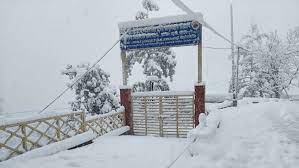भा.कृ.अ.प. - भारतीय कृषि अनुसंधान संस्थान | ICAR-Indian Agricultural Research Institute
| English | || || |
भा.कृ.अ.प. - भारतीय कृषि अनुसंधान संस्थान | ICAR-Indian Agricultural Research Institute
| English | || || |

The IARI Regional Station in its present form was set up on 1st April, 2005 by amalgamating the two regional stations of IARI at Shimla in order to economize on avoidable overhead expenditure. The regional station is thus comprised of two centres viz Cereals Breeding Centre, Tutikandi and Horticulture Crops Research Centre, Dhanda. The administrative office and laboratories are located at the Amartara Campus.
The realization of the fact that annual recurrence of the rusts of wheat and barley took place from their over-summering spores on volunteer plants of wheat, barley and related species at different altitudes in the hills, came in 1934 as a result of pioneering work of late Dr. K. C. Mehta. As a consequence, research work with a scheme for Breeding Rusts Resistant Hill wheat (Barley was added later), was sanctioned in April, 1935 under the charge of Dr. B. P. Pal as a part of the work that he was already handling at IARI with the collaboration of Dr. K. C. Mehta who had been working at the Rust Research Laboratory, Shimla. It was in May 1951, that the Wheat Breeding Station at Tutikandi, Shimla started functioning. The centre is located at 320 N latitude and 770 E longitudes at an altitude of 1900 M above mean sea level (asl). At present the centre accommodates a laboratory building, two glass houses, a field laboratory with store, a small conference hall and about 70 crop grown terraces (approx. 3 hectare).
This Horticultural Research Station was started on 19th October, 1965 as a PL – 480 Scheme (U.S. Aid) Project entitled Collection, Maintenance and Assessment of Wild Germplasm of Pome and Stone Fruits. This project was started initially as a collaborative effort between the Divisions of Horticulture, Plant Pathology and Plant Introduction of IARI and commenced operating from the Plant Introduction Station at Shimla. However, as the activities became fully operative, the space provided was found to be inadequate, the centre was shifted to its present location “Amartara Cottage” in 1969. The experimental farm became operative in 1974.
About 12 hectares (30 acres) of land was also acquired in 1974 on the Shimla – Mandi highway about 6 km from Shimla. Development of the research fields and planting of the collected germplasm at their permanent sites commenced from 1975. The research farm comprises of steep sloppy land with the altitude varying from 1825 m to 1975 m asl; the mean temperature varies from –2oC in winter to nearly 40oC in summer. The mean annual rainfall in 1615 mm, of which 993 mm falls between mid June to mid of September. The area is thus ideally suited for concerted research on temperate fruits.
The horticultural research farm of the station has a well-equipped field laboratory with facilities, a net-housed breeding block, a net house for pot-culture experiments and a temperature-cum-humidity controlled mist house for undertaking plant propagation studies. The field laboratory is equipped for plant pathological, plant propagation and nutritional studies. Irrigation requirements are being met from three perennial water springs along with a storage capacity of about 100,000 litres of irrigation water. All the planted area is provided with drip-cum-fertigation infrastructure.
Laboratory facilities are available at the Regional Station’s Head Office for physiological, in-vitro micro-propagation, hormonal bioassays and plant pathological studies. The station is adequately equipped with office automation facilities and bilingual computers.
This regional station has been reviewing and resetting its research priorities from time to time on the basis of previous findings and the ensuing demands of the hill environments.
Zonal coordination for wheat in the Northern Hills Zone is being undertaken under All India Wheat Improvement Programme for wheat and under All India Barley Network for barley.
